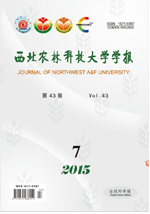
摘要点击排行
全文下载排行



2024年 第52卷 第8期
●动物科学
●生命科学
●农业科学
●园艺科学
●植物保护

1936年创刊 16开

- 主管单位:
- 中华人民共和国教育部
- 主办单位:
- 西北农林科技大学
- 主 编:
- 张 涌
- 常务副主编:
- 申云霞 编审
- 编辑部主任:
- 温晓平 编审
- 通信地址:
- 陕西杨凌西北农林科技大学北校区40号信箱
- 邮政编码:
- 712100
- 电 话:
- 029-87092511
- 电子邮箱:
- xnxbz@nwafu.edu.cn
- 国际刊号:
- ISSN 1671-9387
- 国内刊号:
- CN 61-1390/S
- 国内总发行:
- 全国各地邮局
- 国内邮发号:
- 52-82
- 国外总发行:
- 中国国际图书贸易集团有限公司
- 国外发行代号:
- M8146










